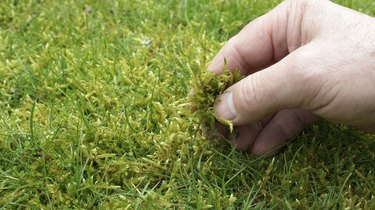
Peat moss is the dried, partially decomposed remains of mosses that grew in very acid bogs and its pH ranges from 3.5 to 4.0, about as acid as orange juice or tomato juice. Dolomite lime has an alkaline reaction and is often used to raise the pH of soil or potting mixes. The amount to add to peat moss depends on the kind of plants you want to grow and the normal pH of your soil.
About Peat Moss
Video of the Day
Most peat moss sold in North America is harvested from bogs in Canada in a sustainable manner. The bogs are drained, stripped of the layers of peat that have accumulated, then allowed to reestablish as active, peat-accumulating bogs. The peat is dried and compressed into bales, then shipped to retailers.
Video of the Day
Peat has a high capacity for holding water. While nutrient-poor itself, it holds nutrients added as fertilizer, preserving them from leaching through the soil. Peat is resistant to decay and its fibrous structure increases the aeration of the soil.
Using Peat Moss With Acid-Loving Plants
Some plants, heathers, rhododendrons, azaleas and blueberries among them, prefer a pH below 6.0. Blueberries, for instance, grow best at a pH of 4.0 to 5.0. If the pH of the soil in your yard is 6.5, adding straight peat without any lime will give you the best results. If your soil tends to be acidic, with a pH of 5.0, you may wish to add a sprinkling of lime when using peat. Dolomite lime is a combination of calcium carbonate and magnesium carbonate and both the calcium and magnesium are beneficial to plant growth.
Using Peat Moss With Vegetables
Most vegetables prefer a soil with a pH close to neutral, though they may tolerate a pH of 6.0. Potatoes are one of the exceptions, growing best in ground with a pH of 4.8 to 6.5. If you choose to add peat to increase the organic matter in the soil, adjusting the pH by also adding dolomite lime will be beneficial. Mix the lime with the peat before digging it into the soil since limestone acts slowly and may require three to six months to fully take effect. While the exact amount of lime will depend on the acidity of your soil, you can add one half to one and a half ounces of dolomite per gallon of peat.
Using Peat Moss In Soil Mixes
Peat moss is a common component of soil mixes because it is sterile, light and well-aerated. Cornell University developed several soil-less potting mix recipes for commercial growers that can be adapted to home use. One, for foliage plants, calls for 1 bushel (approx. 9 gallons) of peat moss, 1 bushel of perlite or vermiculite, 1/2 pound of dolomitic limestone, 1 pound of 5-10-5 fertilizer, and 1 1/2 ounces of 20 percent superphosphate fertilizer.